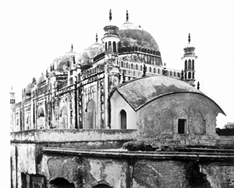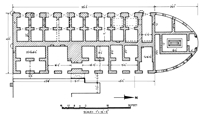Kartalab Khan’s Mosque
Kartalab Khan's Mosque situated in the Begum Bazar area in old Dhaka, was built by Diwan murshid quli khan alias Kartalab Khan in 1701-04. It is also known as the 'Begum Bazar Mosque'.

The mosque with a do-chala annexe to its north occupies the western half of a high vaulted platform and there was a Vav or baoli (stepped well) to the east of the platform. The northern edge of the raised platform, 39.62m from north to south and 13.41m from east to west, has an apse-like appearance. The apse-like part of the platform is cut in the centre to accommodate a tomb-a surcophagus ascribed to the first Imam of the mosque. Underneath the platform are a series of square and rectangular rooms, which are now let out to shopkeepers. On the eastern side of the platform there is a renovated arched-gateway approached by a flight of steps.
It is through this gateway that one can reach the mosque above the platform. A considerably big baoli appears to have been built to provide water for ablutions. Its water level could be reached by a descending flight of stairs through a room. Water from the baoli could be obtained from outside also.
The mosque proper and the do-chala annexe occupy the western half of the vaulted terrace. The remaining part of the terrace was originally kept open, but is now covered with a masonry verandah.

The mosque proper, inclusive of its corner towers, measures 28.65m by 8.23m and is entered from the east through five arched doorways - each opens out under a half-dome and is flanked by slender octagonal turrets which rise above the parapets. There is one doorway each in the middle of the north and south walls. The western wall is internally recessed with five semi-octagonal mihrabs, all showing outward projections with bordering turrets. There is a three-stepped masonry pulpit beside the central mihrab.
The interior of the mosque, forming a large elongated hall (25.60m × 5.18m), is divided into five bays by four transverse arches of plain four-centred design. The central bay is square and bigger than a couple of smaller rectangular ones on either side. All the bays are covered with domes on octagonal drums and crowned with lotus and kalasa finials. The device adopted for the support of the domes is the same as in the lalbagh fort mosque and the satgumbad mosque, both in the city of dhaka. The four octagonal corner towers, all rising above the horizontal parapets and having kalasa bases, are topped by renovated solid kiosks with copulas and finally crowned with lotus and kalasa finials.
Each of these towers is again flanked to right and left by a slender turret, which rises above the parapet and ends in a small copula and kalasa finial.
The rectangular annexe of the mosque to its north is covered with a Bengali type of do-chala hut roof, the eaves of which are pronouncedly curved and drooping. The annexe (6.10m ' 2.13m) has two doorways - one in the centre of the east wall, now renovated, and the other in the middle of the south side. It is through this latter opening that the annexe and the mosque are interconnected. A window has been put in recently in the northern wall of the annexe. Internally the four walls of the room are marked with rectangular and square deep niches, perhaps devised originally as shelves. The curved ridge is exteriorly crowned with five kalasa finials at intervals. This annexe was thought to be a tomb, but probably it was originally meant for the Imam's accommodation since it is still used for that purpose.
In decorating the mosque building greater emphasis was given to architectural elements, such as flanking ornamental turrets of the doorway and mihrab projections, kiosks, cupolas, and lotus and kalasa finials. The doorways and the mihrabs are framed, with crowning rows of merlons. The parapets and octagonal drums are also enriched with merlon motifs. The inside of the domes have basal leaf ornamentation, while there are large medallions containing a rosette motif in the centre. The half-domed vault of the central archway is ornamented with muqarnas work in stucco, now in a crude form. Save these, the entire building is covered with plain plaster, a distinguishing feature of Mughal architecture in Bengal.
The baoli of this mosque, which appears to be a monument by itself, deserves special mention. It is the only one of its kind in Bengal. Its origin may be traced to the Deccan, where Kartalab Khan had long stayed before coming to Bengal. [MA Bari]
